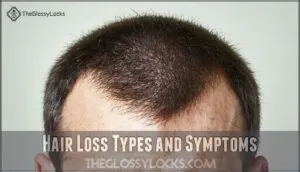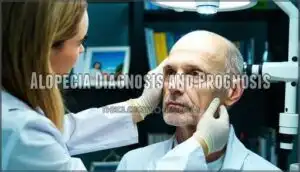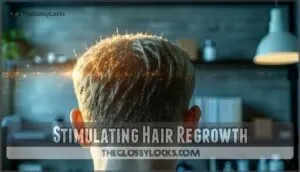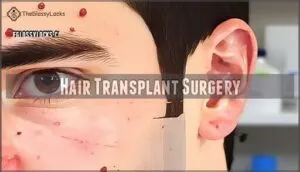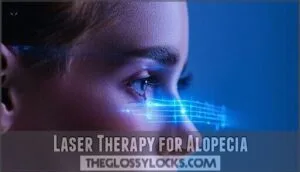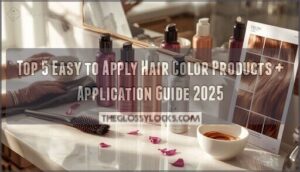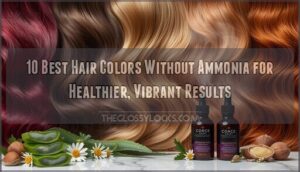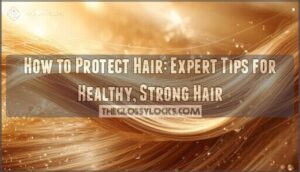This site is supported by our readers. We may earn a commission, at no cost to you, if you purchase through links.
 You’re not powerless against hair loss.
You’re not powerless against hair loss.
Effective hair growth treatment for alopecia includes FDA-approved minoxidil, which can restart dormant follicles in up to 60% of cases.
JAK inhibitors like baricitinib show promising results for severe alopecia areata, while contact immunotherapy triggers regrowth by "tricking" your immune system.
Hair transplant surgery offers permanent solutions for androgenetic alopecia, and low-level laser therapy stimulates cellular activity without side effects.
Your treatment choice depends on your specific alopecia type—what works for patchy loss won’t necessarily help male pattern baldness.
The key lies in understanding which approach matches your condition’s unique fingerprint.
Table Of Contents
- Key Takeaways
- Hair Growth Basics
- Causes of Alopecia
- 6 Best Hair Growth Treatments
- Stimulating Hair Regrowth
- Advanced Hair Growth Solutions
- Frequently Asked Questions (FAQs)
- Is it possible to regrow hair from alopecia?
- How common is alopecia in toddlers?
- What stimulates hair growth for alopecia?
- How to grow hair faster after alopecia?
- Can your hair grow back if you have alopecia?
- How can I stimulate my hair to grow with alopecia?
- What is the best treatment for alopecia?
- What is the fastest way to cure alopecia?
- Can alopecia be prevented from reoccurring?
- How long does it typically take for hair to regrow?
- Conclusion
Key Takeaways
- Treatment effectiveness depends on your alopecia type – you’ll need different approaches for androgenetic alopecia versus autoimmune alopecia areata, with success rates varying from 35% to 82% depending on the method you choose.
- FDA-approved treatments offer proven results – minoxidil shows 35% improvement rates, while JAK inhibitors like baricitinib achieve over 30% significant scalp coverage within 24 weeks for severe cases.
- Advanced therapies provide hope when basics fail – contact immunotherapy achieves 74.6% regrowth rates, hair transplant surgery offers 95-100% success rates, and low-level laser therapy stimulates dormant follicles through enhanced cellular activity.
- Consistency and realistic expectations are essential – you’ll typically need 4-6 months of treatment before seeing visible results, and combining approaches like proper nutrition, stress management, and medical treatments maximizes your success potential.
Hair Growth Basics
Before you tackle alopecia treatments, you need to understand how hair actually grows.
Your hair follicles follow a predictable three-stage cycle that determines when strands grow, rest, and eventually fall out naturally.
Hair Structure and Biology
Your hair growth story starts with five million Hair Follicles formed before birth.
These tiny structures house your hair’s Keratin Structure – three protective layers that determine Hair Texture and strength.
Sebaceous Glands produce natural oils that travel down straight hair easily but struggle with curly textures.
Understanding your hair’s biology helps you choose effective alopecia treatments that work with your Scalp Health needs.
Hair Follicle and Shaft
Understanding your hair follicle stimulation starts beneath the surface.
Each hair follicle houses specialized cells that produce keratin layers, forming your hair shaft. This underground powerhouse determines hair texture and follicle health through intricate biological processes.
Think of follicles as tiny factories—when they’re healthy, they manufacture strong strands.
Damaged follicles compromise shaft care, affecting hair growth treatment effectiveness and overall hair structure.
Hair Growth Stages
Your hair follicles cycle through three distinct growth stages that directly impact treatment success.
The anagen phase represents active growth, lasting several years when follicle stimulation works best. During the brief catagen stage, hair shifts and detaches from blood supply.
The telogen phase marks a three-month resting period before shedding. Understanding these hair growth cycles helps optimize treatment timing for maximum regrowth potential.
Effective hair care involves understanding the hair growth cycle to promote healthy hair development.
Causes of Alopecia
You’ll encounter alopecia when your immune system mistakenly attacks your hair follicles, causing sudden hair loss in round patches on your scalp or body.
Understanding the specific type you’re dealing with helps determine the most effective treatment approach for your situation.
Hair Loss Types and Symptoms
Several distinct types of hair loss can affect you, each presenting unique Alopecia Signs and symptoms.
Androgenetic alopecia causes gradual Hair Thinning at your crown and temples.
Alopecia areata creates sudden bald patches, while telogen effluvium triggers widespread Hair Shedding.
Scalp Conditions like seborrheic dermatitis can worsen hair loss prevention efforts, making early recognition of these Baldness Causes critical for effective alopecia treatment and hair loss solution strategies.
Alopecia Diagnosis and Prognosis
Getting the right alopecia diagnosis starts with a dermatologist examining your scalp and hair loss patterns.
They’ll use trichoscopy for detailed scalp analysis and may perform diagnostic tests like pull tests or biopsies.
Your prognosis factors include age of onset, extent of hair loss, and family history.
Early androgenetic alopecia often responds better to hair growth treatment than extensive alopecia symptoms appearing later in life.
Accurate diagnosis involves evaluating hair loss causes to determine the best course of treatment.
Management of Patchy Hair Loss
Managing patchy hair loss requires targeted scalp treatment and consistent hair regrowth tips.
You’ll need specialized alopecia management strategies that address specific affected areas. Hair loss prevention starts with gentle cleansing using sulfate-free products and avoiding harsh styling.
Apply topical treatments directly to patches for effective hair regeneration. Regular scalp massage improves circulation, supporting natural hair growth treatment.
Patchy hair care involves protecting remaining strands while encouraging new growth in affected zones, using techniques like gentle cleansing and promoting natural hair growth.
6 Best Hair Growth Treatments
You’ll find that effective hair growth treatments for alopecia combine targeted ingredients with consistent application to maximize follicle stimulation.
These six clinically-backed options address different underlying causes while supporting your scalp’s natural regenerative processes.
1. Redken Moisture Restore Hair Treatment
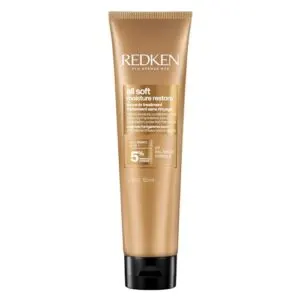
Can hair growth treatments really restore what you’ve lost to alopecia? Redken All Soft Moisture Restore Leave-In Treatment doesn’t directly stimulate new follicle growth, but it’s clinically proven to enhance existing hair health.
With hyaluronic acid and argan oil, this lightweight formula delivers 72-hour moisture retention and heat protection up to 450°F.
While it won’t cure alopecia, it strengthens damaged strands, reduces breakage by improving detangling efficiency tenfold, and creates ideal conditions for healthier-looking hair during your recovery journey.
Understanding the role of key hair ingredients is vital for effective hair growth treatment and maintenance.
Best For: People with dry, damaged, or frizzy hair who want to improve moisture retention and manageability without adding weight to their strands.
- Provides 72-hour moisture retention with hyaluronic acid and argan oil for long-lasting hydration
- Offers heat protection up to 450°F while making hair 10x easier to detangle, reducing breakage
- Lightweight, non-greasy formula suitable for daily use that won’t weigh down fine to medium hair
- Won’t stimulate new hair growth or treat the underlying causes of alopecia
- Some users report dryness or straw-like texture with prolonged use, potentially due to protein sensitivity
- Works best as part of the complete All Soft system, requiring additional product purchases for maximum results
2. Purple conditioner for blonde hair
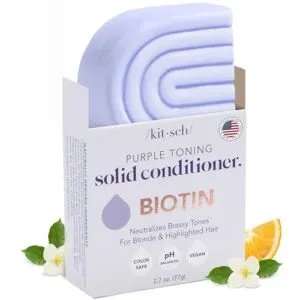
While many consider purple conditioner purely cosmetic, it’s actually a valuable treatment for maintaining healthy blonde hair affected by alopecia.
The violet pigments neutralize yellow and brassy tones that can make sparse hair appear more noticeable. You’ll find that biotin-enriched formulas strengthen remaining strands while pH-balanced ingredients prevent further damage.
This gentle approach protects fragile regrowth without harsh chemicals. Regular use creates fuller-looking coverage by enhancing your hair’s natural shine and texture, making thinning areas less apparent while supporting overall scalp health.
Best For: People with blonde, gray, or color-treated hair experiencing alopecia who want to neutralize brassy tones while strengthening remaining strands and making thinning areas less noticeable.
- Bar format requires adjustment period and tends to break into pieces, making storage challenging
- May cause dryness or color buildup if overused, particularly problematic for already fragile hair
- Less effective on low-porosity or non-bleached hair, limiting results for some hair types
- Neutralizes yellow and brassy tones while biotin strengthens fragile hair affected by alopecia
- Creates fuller-looking coverage by enhancing shine and texture, making sparse areas less apparent
- Gentle, chemical-free formula supports scalp health without stripping color or causing further damage
3. Hyaluron Plump Hydrating Shampoo Care
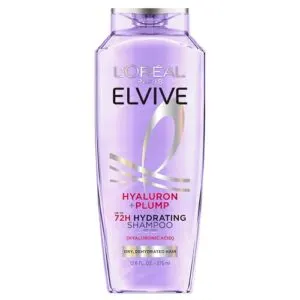
Surprisingly, hyaluronic acid shampoos don’t just plump your skin—they’re revolutionizing alopecia care too.
L’Oréal’s Hyaluron Plump delivers 72-hour moisture retention, creating an ideal scalp environment for follicle health.
Clinical studies show over 54% reduction in hair loss within 90 days when hyaluronic acid treatments support androgenetic alopecia management.
You’ll notice stronger, more resilient strands that resist breakage while enhanced scalp hydration nourishes weakened follicles, supporting your hair’s natural growth cycle.
Best For: People with androgenetic alopecia or thinning hair who want to improve scalp health while maintaining daily hair cleansing and hydration.
- Clinical evidence shows 54% reduction in hair loss within 90 days through improved scalp hydration and follicle nourishment
- Delivers 72-hour moisture retention without weighing hair down, supporting stronger strands that resist breakage
- Paraben-free formula suitable for daily use on all hair types, including color-treated and damaged hair
- May cause dry ends and greasy roots on non-wash days for some users, requiring careful application technique
- Requires significant product amount for effective lathering, potentially increasing cost per use
- Mixed user experiences with scent and some report rough, frizzy texture with the accompanying conditioner
4. clarifying shampoo for oily hair
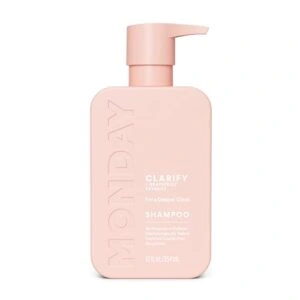
When excess oil weighs down your scalp, clarifying shampoo cuts through the buildup like a reset button for your hair follicles.
You’ll remove sebum, styling products, and environmental debris that can clog follicles and impede healthy growth.
Use it weekly to maintain ideal scalp conditions without overdrying.
Key ingredients like grapefruit extract and salicylic acid deep-cleanse while preserving your hair’s natural moisture balance, creating the clean foundation your follicles need to thrive.
Best For: People with oily, fine hair who experience frequent buildup from styling products and excess sebum production.
- Deep cleanses to remove oil, product residue, and environmental debris that can clog follicles and weigh down hair
- Contains gentle yet effective ingredients like grapefruit extract and ceramides that cleanse without over-stripping natural oils
- Extends time between washes and adds volume by eliminating buildup that makes hair appear flat and greasy
- May not effectively remove heavy styling product buildup or work well for those with very dry or sensitive scalps
- Can cause dryness, brittleness, or rebound oil production if used too frequently (more than once weekly)
- Some users report mixed results with packaging functionality and find it less effective for deep cleansing compared to stronger formulas
5. strengthening shampoo for damaged hair
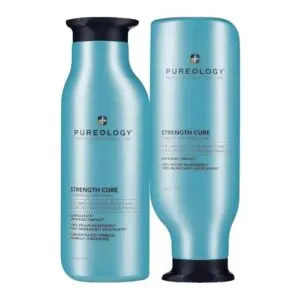
For damaged hair struggling with breakage, strengthening shampoos offer proven repair benefits.
These specialized formulas contain amino acids, biotin, and proteins that reinforce hair bonds and reduce breakage by up to 56% after one use.
Clinical studies show they fill porous, damaged areas while forming protective barriers against styling stress.
The key lies in consistent use—your hair needs time to rebuild its foundation for lasting strength.
Best For: People with damaged, brittle, or color-treated hair experiencing significant breakage and seeking professional-grade repair solutions.
- Requires consistent, ongoing use for lasting results and cannot permanently reverse severe structural damage
- More expensive than drugstore alternatives, though considered worth the investment for quality ingredients
- Hair may adjust quickly to formulas, potentially requiring rotation with other products for continued effectiveness
- Clinically proven to reduce breakage by up to 56% after just one use through bond-repairing technology
- Contains amino acids, biotin, and proteins that fill porous hair areas and reinforce structural integrity
- Forms protective barriers against heat styling and environmental damage while maintaining color vibrancy
6. Biolage Strength Recovery Hair Care
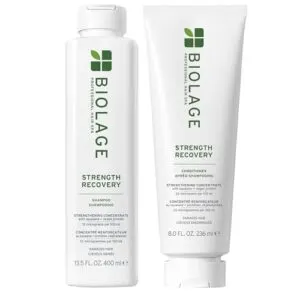
Strengthen brittle strands with Biolage’s clinically-proven recovery system.
This powerhouse duo delivers 3x stronger hair after just one use, while reducing breakage by up to 73%.
Formulated with distilled olive squalane and vegan proteins, it replenishes lipids lost from heat styling and chemical damage.
The lightweight formula won’t weigh down fine hair, making it perfect for overprocessed strands.
You’ll notice improved manageability and lasting shine that builds with each wash, giving damaged hair the comeback story it deserves.
Best For: People with dry, damaged, or chemically-treated hair who need serious repair and strengthening without weighing down fine strands.
- Delivers clinically-proven results with 3x stronger hair and up to 73% less breakage after one use
- Lightweight, vegan formula with olive squalane and proteins that won’t weigh down fine or damaged hair
- Award-winning product (2023 Allure Best of Beauty) that’s cruelty-free and suitable for color-treated hair
- Higher price point compared to drugstore alternatives, though still cost-effective due to small usage amounts needed
- Some users may experience rare sensitivity or scalp irritation despite gentle formulation
- Focuses on surface-level damage repair rather than internal hair bond reconstruction like bonding treatments
Stimulating Hair Regrowth
When traditional treatments haven’t restored your hair growth, specialized medical therapies can target alopecia at the cellular level.
These evidence-based approaches work by either stimulating dormant follicles or suppressing the immune response that causes hair loss.
Minoxidil (Rogaine)
Minoxidil opens up your scalp’s blood vessels, delivering essential nutrients that kickstart dormant hair follicles back into action.
This FDA-approved hair growth serum converts to minoxidil sulfate in your scalp, extending the anagen phase for stronger hair regrowth therapy.
Transform your scalp into a growth powerhouse with targeted follicle activation therapy.
The mechanism of minoxidil involves vasodilation effects that enhance blood flow to the scalp, promoting hair growth.
- Minoxidil effects: 5% solution shows 35% significant improvement in alopecia treatment studies
- Rogaine benefits: Increases hair density by stimulating VEGF and growth factor production
- Scalp health: Enhances oxygen delivery through vasodilation for ideal follicle function
- Hair loss remedies: 82% response rate in alopecia areata cases over 27 weeks
- Treatment timeline: Requires 4-6 months of consistent use for visible results
Contact Immunotherapy
Unlike topical treatments that work gradually, contact immunotherapy takes a completely different approach to hair growth treatment.
This therapy creates a controlled allergic skin reaction that "distracts" your immune system from attacking hair follicles.
Doctors use chemicals like diphencyprone (DPCP) as topical immunomodulators for skin sensitization.
Studies show 74.6% of alopecia patients achieve some hair regrowth , making this hair regrowth therapy a viable option when other hair loss remedies fail.
JAK Inhibitors
JAK therapy represents a breakthrough in alopecia areata treatment.
These oral inhibitors target immune pathways attacking your hair follicles, allowing natural hair regrowth to resume.
Clinical trials show over 30% of patients achieve significant scalp coverage within 24 weeks.
FDA-approved options like baricitinib and deuruxolitinib offer hope for hair restoration through targeted medical research and proven inhibitor benefits.
Advanced Hair Growth Solutions
When conventional treatments aren’t enough, advanced hair growth solutions offer hope for people with stubborn alopecia cases.
These cutting-edge approaches include surgical interventions, light-based therapies, and thorough lifestyle strategies that target hair loss from multiple angles.
Hair Transplant Surgery
Hair transplantation offers surgical options for permanent hair restoration when other treatments fail.
Modern grafting techniques like FUE achieve 95-100% success rates, making this hair growth surgery highly effective for alopecia areata.
While transplant costs vary, the recovery process typically spans several months.
Hair loss treatment through transplantation provides lasting results for many patients, and patients should consider hair regrowth treatment options before undergoing surgery to guarantee the best possible outcome, ensuring the best possible outcome.
Laser Therapy for Alopecia
When dealing with stubborn alopecia, low-level laser therapy offers a breakthrough approach to hair regrowth.
This FDA-approved photobiomodulation treatment uses specific wavelengths to stimulate dormant follicles, promoting hair regeneration through enhanced cellular activity.
Clinical studies show significant increases in hair density after consistent use, making laser treatment a game-changer for alopecia care.
The effectiveness of laser therapy is often attributed to its ability to enhance laser hair growth processes, leading to improved treatment outcomes.
Natural Hair Regrowth Methods
Several natural approaches can complement medical treatments for alopecia.
These methods focus on supporting your scalp’s health through gentle, evidence-based techniques that won’t interfere with conventional therapies.
- Herbal Remedies like saw palmetto and green tea extract show promising results in clinical studies
- Scalp Massage with Natural Oils increases blood circulation and creates a relaxing self-care ritual
- Aromatherapy treatments using rosemary and peppermint oils provide therapeutic scalp treatment benefits
- Dietary Changes supporting hair growth supplements can strengthen follicles from within
These natural hair growth tips work best when combined consistently over time.
Using hair growth products can also enhance the effectiveness of these methods.
Maintaining Healthy Hair With Proper Nutrition
Proper nutrition acts as your hair’s foundation, supplying the building blocks for strong growth.
A nutrient-dense diet rich in protein, iron, and vitamin D supports healthy follicle function.
Hair vitamins and minerals like biotin, zinc, and omega-3s strengthen strands from within.
Balanced nutrition beats expensive treatments—your plate holds the power to transform thinning hair naturally, with nutrient-dense diet being key.
Frequently Asked Questions (FAQs)
Is it possible to regrow hair from alopecia?
Like a garden awaiting spring’s touch, your follicles hold potential for renewal.
You can regrow hair from alopecia, though success depends on the specific type you’re experiencing.
Some forms respond well to treatments like minoxidil or immunotherapy.
How common is alopecia in toddlers?
Alopecia affects roughly 1-2% of toddlers, making it relatively uncommon in this age group.
You’ll typically see patchy hair loss that can resolve spontaneously, though early pediatric consultation helps rule out underlying conditions.
What stimulates hair growth for alopecia?
You’re not expecting miracles overnight when dealing with hair regrowth.
Minoxidil increases blood flow to follicles, while corticosteroids suppress immune reactions.
Light therapy stimulates follicles directly.
These treatments work progressively to restore your hair’s natural growth cycle.
How to grow hair faster after alopecia?
Boost regrowth with corticosteroid treatments and minoxidil. You’ll accelerate recovery by combining medical therapies with scalp massage, balanced nutrition, and stress management for maximum follicle health restoration.
Can your hair grow back if you have alopecia?
Your hair can regrow with alopecia, depending on the type you’re facing. Androgenetic alopecia responds well to treatments like minoxidil, while autoimmune alopecia areata often recovers naturally within months.
How can I stimulate my hair to grow with alopecia?
Like tending a garden after winter’s harsh grip, you’ll need patience and proven methods to coax new growth.
Try minoxidil, scalp massage, anti-inflammatory treatments, and consult dermatologists for targeted therapies that match your specific alopecia type.
What is the best treatment for alopecia?
Treatment approaches depend on severity and extent. JAK inhibitor baricitinib and ritlecitinib are FDA-approved for severe cases. For patchy hair loss, corticosteroid injections remain effective first-line therapy.
What is the fastest way to cure alopecia?
Currently, no treatments can quickly "cure" alopecia since it’s often an autoimmune condition requiring ongoing management.
You’ll find faster regrowth with prescription medications like minoxidil, finasteride, or corticosteroid injections rather than expecting instant results from any single approach.
Can alopecia be prevented from reoccurring?
You can’t completely prevent alopecia recurrence, but consistent stress management, gentle hair care, and avoiding harsh treatments help reduce flare-ups. Early intervention when symptoms appear minimizes severity.
How long does it typically take for hair to regrow?
Your hair’s journey back resembles a phoenix rising from ashes – slow but steady regrowth typically takes three to six months.
Though you’ll see initial stubble within weeks of starting treatment.
Conclusion
Remember the Greek myth of Antaeus, who drew strength from touching earth? Your hair follicles work similarly—they need the right treatment to reconnect with their power source.
Hair growth treatment for alopecia isn’t one-size-fits-all. Minoxidil works for 60% of users, while JAK inhibitors target autoimmune causes effectively.
Contact immunotherapy and laser therapy offer additional options. You’ll see results by matching your specific alopecia type with the appropriate treatment approach.
Consistent application and realistic expectations remain essential for success.
- https://nyulangone.org/conditions/hair-loss/treatments/medication-for-hair-loss
- https://www.frontiersin.org/journals/pharmacology/articles/10.3389/fphar.2025.1556705/full
- https://pmc.ncbi.nlm.nih.gov/articles/PMC9298335/
- https://www.goodrx.com/conditions/alopecia/alopecia-areata-treatment-trials
- https://www.alviarmani.com/hair-loss-treatment-for-men-breakthrough-options-in-2025/

